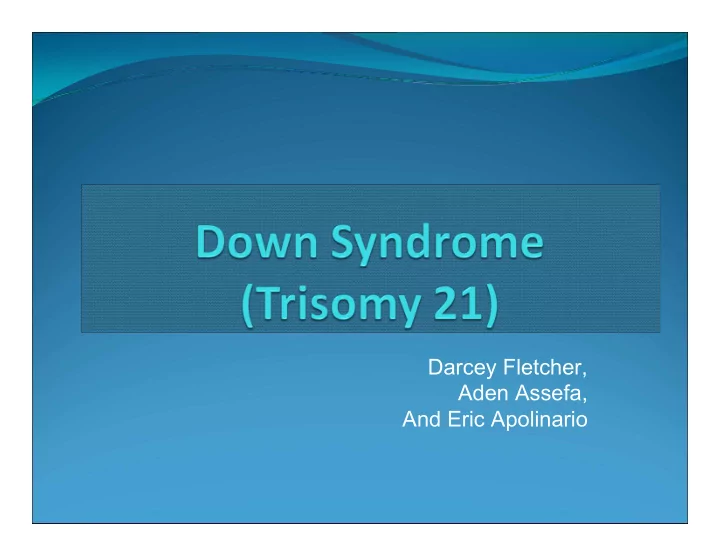

Darcey Fletcher, Aden Assefa, And Eric Apolinario
“Trisomy”: Possessing three copies of a particular chromosome instead of the normal two copies. “21” The 21 st chromosome
Down Syndrome (Trisomy 21): A Genetic disorder caused by the presence of all or part of an extra 21 st chromosome. Named after John Langdon Down 1 out of 800-1,000 births affected
Karyotype of Trisomy 21: 47, XY, +21 47: Total # of chromosomes (46 is normal) XY: Sex Chromosomes (male) +21: Designates the extra chromosome as 21
Signs/Symptoms of Trisomy 21 Lower than average cognitive ability (IQ of 35-70) Single transverse palmer crease (1 instead of 2 creases across palm(s)) Almond shaped eyes caused by epicanthic folds of eyelids Upslanting palpebral fissures Shorter limbs, neck, and excessive joint laxity Poor muscle tone Larger than normal space between big and 2 nd toes Protruding tongue Flat nasal bridge White spots on iris Single flexion furrow of 5 th finger AT HIGHER RISK FOR: congenital heart disease, recurrent ear infections, obstructive sleep apnea, and thyroid dysfunctions
Parental Screening Parental Screening Amniocentesis (invasive) Chronic Villus Sampling (CVS) (also invasive) Percutaneous Umbillical Blood Sampling (PUBS) These procedures are generally performed on women 30 +years old with a greater risk
Non-Invasive Procedures Screen Weeks Detection False Description Rate Gestatio Positive n Rate Triple 15-20 75% 8.5% measures the maternal serum (a fetal liver protein), estriol, a Screen pregnancy hormone, and hCG, a pregnancy hormone) [ Quad 15-20 79% 7.5% measures the maternal serum (a fetal liver protein), estriol, a Screen pregnancy hormone, hCG, a pregnancy hormone) , and and high inhibin-Alpha (INHA) AFP/Free 13-22 80% 2.8% This test measures the alpha feto protein, produced by the fetus, beta scan and free beta hCG, produced by the placenta Nuchal 10-13.5 91% 5% Uses ultrasound to measure Nuchal TranslucencyTin addition translucency to the freeBeta hCGand PAPPA /free (pregnancy-associated plasma beta/PAPPA protein A). screen
Possible (medical) treatment None that will provide a cure None that will provide a cure Kids benefit from medical intervention starting at infancy Kids will be assigned a team of specialists (cardiologist, gastroentrenologist, developmental pediatrician etc) Kids will benefit from: physical therapy, speech pathology, occupational therapy, and others to help develop skills as well as possible Early Intervention Programs: Early Intervention Programs: Kids are stimulated at an early age with appropriate activities Goal of programs: to help your baby develop motor skills, language, social skills, and self-help skills
What may my child look like? Physical characteristics of normal parents: Parent 1: Parent 2: Parent 1: Parent 2: Black hair (BBRR) Blonde hair (bbRR) BB= two dominant alleles for black hair bb= 2 recessive alleles for blonde hair RR= 2 dominant alleles for not red hair RR= 2 dominant alleles for not red hair Brown eyes (EE) Blue eyes (ee) EE= two dominant alleles for brown ee= 2 recessive alleles for blue eyes eyes
Punnett Squares B B BR BR Bb Bb BbRR BbRR b (Brown Eyes) (Brown Eyes) (Black hair) (Black Hair) bR Bb Bb BbRR BbRR b (Brown Eyes) (Brown Eyes) (Black hair) b (Black hair) R 4/4 100% Black 4/4 100% Brown haired offspring Eyed offspring
Result: Black hair, Brown eyes Also with down syndrome Also with down syndrome features including but not limited features including but not limited to: Almond shaped eyes caused to by epicanthic folds of eyelids Upslanting palpebral fissures Shorter limbs, neck, and excessive joint laxity Poor muscle tone Larger than normal space between big and 2 nd toes Protruding tongue Flat nasal bridge White spots on iris
What to expect Children with down syndrome can generally do what most other children can do (walking, being toilet trained, etc) but usually do them later than normal children Many babies with down syndrome are born with medical problems needing surgery There are special programs beginning in the preschool years to help children with Down syndrome develop skills as fully as possible While there are special work programs designed for adults with Down syndrome, many people with the disorder can hold regular jobs In general, for women under 40 (after having one child with Down syndrome), the chance of having another baby with Down syndrome is 1 %, but increases with age there is no reason to believe that a parent could have done anything to cause or prevent the birth of their baby with Down syndrome. Kids with Down syndrome benefit from loving homes, early intervention, inclusive education, appropriate medical care and positive public attitudes. Life expectancy has increased greatly from 25years in 1980 to 49 years in 2002
Links Used http://www.ndsccenter.org/resources/package3.php http://en.wikipedia.org/wiki/Hair_color http://www.yale.edu/ynhti/curriculum/units/1982/7/82. 07.06.x.html http://en.wikipedia.org/wiki/Down_syndrome http://www.mayoclinic.com/health/down- syndrome/DS00182/DSECTION=7 http://dir.yahoo.com/Health/Diseases_and_Condition s/Genetic_Disorders/
Recommend
More recommend